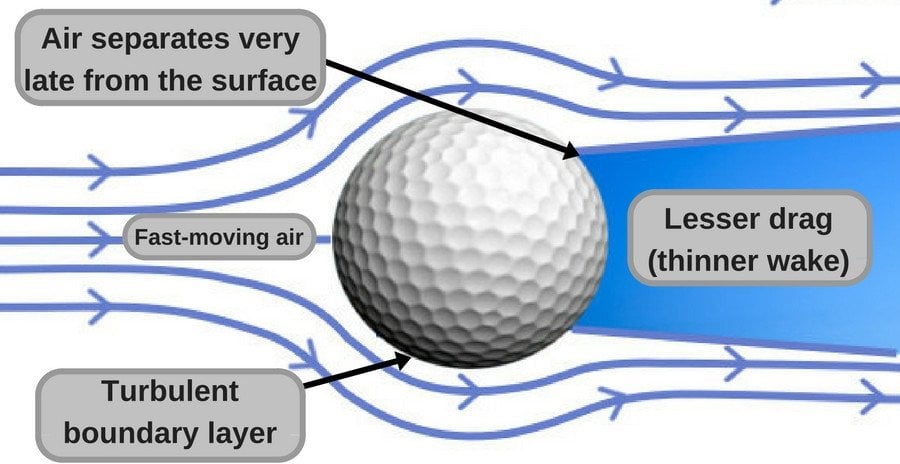Table of Contents (click to expand)
A golf ball has dimples on it to help it travel farther. The dimples create turbulence in the air which reduces drag on the ball.
Here’s a fun fact: back in the 17th century, people actually played with golf balls made of wood. The wooden design was replaced by a leather pouch stuffed with feathers, which remained the standard design for nearly two centuries, until someone noticed that a scuffed-up ball traveled much farther than a smooth one.
Thus, the era of dimpled golf balls dawned.
Recommended Video for you:
The Golf Ball

In order to be used in official matches and tournaments, a golf ball must meet certain criteria: it should be 4.27 centimeters (1.68 inches) in diameter and its maximum weight shouldn’t exceed 45.93 grams. It should also have a number of depressions or ‘dimples’ on its surface (there are a few other requirements as well). While the former two requirements seem perfectly logical, it’s the last one that strikes most people as a bit odd.
Why Do They Need To Put Dimples On Golf Balls?
Well, we answered this already – when it was first observed that scuffed-up balls or those with irregularities on their surface travelled farther than new, smooth ones, golf balls underwent a structural change and dimpled golf balls came onto the scene. However, why do dimpled balls travel faster than smooth ones? Let’s find out.

Anything that moves through air faces a number of forces; the flight of a golf ball involves two principal forces – lift and drag. While drag is a resistive force that slows the ball down as it moves, lift provides an upward force on the ball, making it go higher. To ensure that your golf ball goes farther and higher, you want to reduce drag while increasing lift.
As soon as the ball is hit, it goes airborne and air starts flowing over its contours of the front side, and eventually separates from the ball at its back side. Since the ball is moving at such a high speed, it creates a region of turbulence in its wake where the air pressure is low, due to the fluctuation in air flow. It’s this region of turbulence that makes all the difference in the way the ball moves.
Now, let’s look at the nature of airflow in a smooth and a dimpled ball, respectively.
Smooth Golf Ball

As you can see in the image above, the air that comes in contact with the front part of the ball separates quickly on the back side, resulting in a much wider wake behind the ball. A bigger wake means a larger area of low air pressure, which means higher drag. A sort of suction is created in that region, which pulls on the ball and greatly resists its forward motion, hence reducing the ball’s speed.
Dimpled Golf Ball

In a dimpled ball, however, the airflow changes drastically. The oncoming air enters and exits the tiny dimples (depressions on the surface), thereby spending slightly more time moving over the surface of the ball before leaving it on the back side. Therefore, a much smaller wake is created behind the ball, which reduces drag, i.e. the backward pull on the ball. That’s why a dimpled ball is able to travel much faster and cover a greater distance than a smooth golf ball.
Lift Generated By A Dimpled Ball
A dimpled golf ball not only accelerates faster than a smooth one, but it can also attain more lift, provided there is significant backspin on the ball. Backspin makes the air move backwards faster on the top of the ball than at the bottom, thanks to the dimples. Again, this dimple design creates a region of low pressure above the ball and one of high pressure below the ball, which provides more lift to keep the dimpled ball airborne a little longer.
Here’s an interesting video of the United States Golf Association (USGA) explaining the role of dimples on golf balls:
Before we finish, here’s a quick question: if dimples help reduce drag and provide a bit of lift, then why don’t airplanes, choppers and automobiles also have dimples on their exteriors?
Well, there’s a reason behind that too, but that’s a topic for another day.













